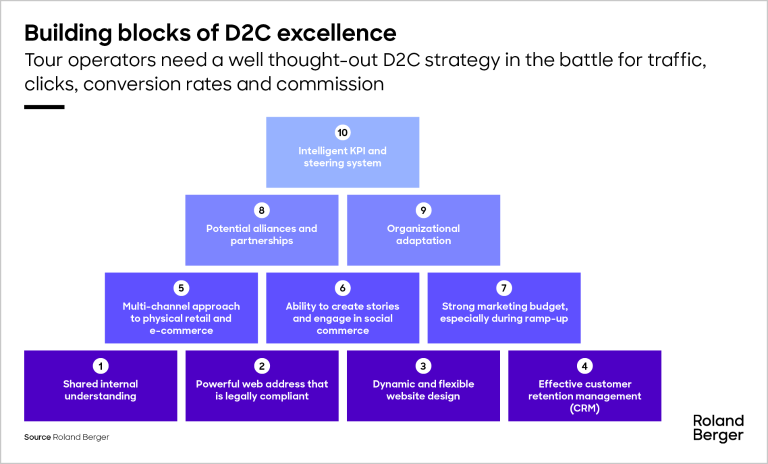Roland Berger’s research shows that when it comes to consumer behavior patterns, there is no going back to pre-Covid times.


D2C challenges: The travel industry
A shift in shopping behavior is pushing direct-to-consumer distribution to the top of the business strategy agenda
Industries that deal with consumer products must face the reality that consumer behavior has evolved through digitalization. Rather than buying through legacy intermediaries, shoppers are increasingly making their purchases directly, via aggregators, price comparison websites and newly emerging purchase formats such as social media commerce. This shift in behavior is pushing direct-to-consumer (D2C) distribution to the top of the business strategy agenda of consumer product companies. We investigate the changes taking place in the travel industry as an example of what this means for companies, identify ten key building blocks for achieving D2C excellence, and describe how companies can actively embrace a D2C strategy.

"Today’s consumers increasingly book online; D2C is a must-have solution for many consumer goods producers and especially for tour operators. The effort cannot be overestimated and half-hearted D2C approaches will be doomed to fail."
A revolution in travel
Tour operators traditionally sell package vacations including flights, hotels and services at the holidaymaker's final destination. Now, however, travelers are increasingly turning to digital platforms and aggregators in search of the best deals. In recent years, aggregators have wreaked havoc on the profit and loss statements of tour operators as the preferred channel for vacation-related purchases. At the same time, online travel agents have expanded their footprint to include travel packages, eating into the core business of legacy tour operators.
As a result, D2C has become the inevitable next step, a must-have solution for tour operators. By selling directly to consumers, tour operators can avoid traditional agent commissions and better tailor their products and services to consumers. Already, many company executives have D2C ambitions – but so far only a small minority have taken the necessary steps to realize those ambitions. D2C means far more than just having your own website: It also means doing things such as connecting touchpoints along the customer journey, winning the competition for web traffic and ensuring price competitiveness.
Building blocks for excellence
Tour operators need to put themselves back in the driver's seat of the travel industry. They can do this by systematically striving for excellence in the field of D2C. We identify ten building blocks for achieving such excellence: a shared internal understanding, a powerful web address, a truly dynamic website, effective customer retention management, a multichannel approach that combines physical retail and e-commerce, the ability to create stories and become a social media player, a strong marketing budget (especially during the D2C ramp-up phase), potential horizontal or vertical strategic partnerships and alliances, organizational adaptation, and an intelligent KPI and steering system. These ten elements form the basis of a power play that can help companies take back control.
Each of the ten building blocks listed above merits a detailed discussion. To take one example, customer retention management – or CRM – should include a number of distinct elements, such as commitment to the continuous expansion of consumer accounts through diverse entry points, effective strategies for capturing consumers who initially come through other channels, AI-based customer segmentation that focuses on individual needs, an in-depth understanding of consumer preferences, behaviors and desires, and an attractive loyalty program that encourages repeat business. Crucially, tour operators should view customer relationships as multiyear or even never-ending connections, not one-time interactions.
Actively embracing D2C
By implementing a D2C strategy, consumer-oriented companies not only ensure their independence in the face of aggregators but also unlock unprecedented opportunities to connect with their customers. We recommend a four-step initial approach to overcoming the challenges. First, look into the mirror, reviewing your past performance, checking out what competitors are doing and determining your need for D2C in the light of your current e-commerce business. Second, find answers to strategic questions – such as where to play and how to win – and define an overall distribution strategy that includes D2C as one of its key parts. Third, devise an operating model that has all the capacities, capabilities, tools and structures needed to deliver the chosen distribution strategy. And finally, commit to a roadmap that indicates clear responsibilities and actions.
Interested in how D2C can transform your business? Download our full report below.
We would like to thank Severin Bischof for co-authoring this article.
Register now to access the full study, to learn about the changes taking place in the travel industry and how companies can actively embrace a D2C strategy.







